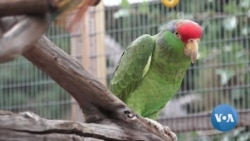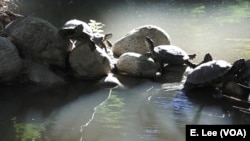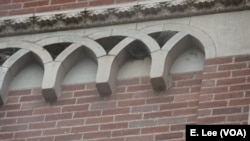At sunset every day, an almost deafening sound from the sky can be heard in a community just east of Los Angeles. It is the sound of parrots that have become a familiar part of life here.
“There’s poop everywhere,” said Havolynn Rose Owaleon. But she and many of the residents in this area have gotten used to the parrots.
“They’re not quiet at all, but you know, it’s something that you listen for, ’cause if I didn’t hear them on a daily basis, then I know something is really wrong,” Owaleon said.
Feathered immigrants
Red-crowned parrots, now a part of the ecosystem in Southern California, are descendants of immigrants. They are originally from Tamaulipas, Mexico, where they are now endangered.
They were poached in their native habitat, arrived in the United States and sold as pets. Some of the parrots escaped or were released and have since multiplied and thrived in an urban environment.
“They are good at making a habitat for themselves in major cities, and this is what happened in Pasadena and East L.A. So, these are birds that live pretty much exclusively off of trees that are also not native to our area,” explained Ursula Heise, who teaches at the University of California Los Angeles (UCLA) Department of English and at the Institute of the Environment and Sustainability.
As transplants to Southern California, the red-crowned parrots have become such permanent fixtures that they are on the California Bird Records Committee’s list of birds in the state.
“They’ve been naturalized as California citizens,” Heise said.
Cold-blooded immigrants
Often seen basking under the California sun near a body of water, red-eared slider turtles also are not native to the U.S. West Coast but originally immigrated here as pets, then were released or escaped into the wild. Native to the central United States, the turtles have adapted and thrived across the United States and around the globe.
“Because this species is so commonly exploited for food and the pet industry, it’s the one that gets released the most often,” said Brad Shaffer, UCLA distinguished professor of ecology and evolutionary biology and director of the La Kretz Center for California Conservation Science.
Urban haven
The success of the red-eared slider turtles and red-crowned parrots in the Los Angeles area have some academics wondering whether a city can be a place to help endangered non-native animals, similar to the role of a zoo but better.
“At least it’s living in the wild. It’s making its own living. It’s having the lifestyle that turtles or that parrots should have; it’s just doing it in a different place,” Shaffer said.
“We have put up major buildings. We’ve put up expanses of concrete. We’ve introduced a completely different vegetation, and in many cases, that’s led to a reduction of biodiversity because a lot of our created habitat is not hospitable to the native species. But the other side of that is that we’ve created new ecological niches and new kinds of habitats,” Heise said.
These artificial habitats could become new homes for birds, bugs or other creatures whose native home may be threatened.
Shaffer said any non-native species that is introduced would have to be carefully picked to minimize the risk of causing harm to the existing wildlife population in the city and beyond.
“There’s always that danger, and I think the real question is, can we minimize that danger by doing sort of the best possible ecological science to be able to identify species that will thrive in cities and won’t thrive outside of cities?” Shaffer said.
Even without human intervention, Shaffer warns that species will migrate outside of their native environment, potentially causing harm.
“I think we will have a lesser chance of that going on if we have some strong science behind it, compared to if we just sit back with our heads in the sand and wait,” Shaffer said.













